How Much Does It Cost To Install A Chimney
Hide
In this guide
Chimney Installation Cost
Chimney Construction Cost by Size
Chimney Cost by Number of Flues
Chimney Installation Cost by Type
Chimney Replacement
Chimney Installation Process
Chimney Advantages and Disadvantages
Chimney Maintenance Cost
Chimney Crown vs Cap
Enhancement and Improvement Costs
Additional Considerations
FAQs
Chimney Installation Cost
Labor makes up a big part of the cost of a chimney. This is especially true for a masonry chimney, where the materials are fairly inexpensive. However, the labor to put them together can be very time-consuming. For an engineered fireplace, the labor is the lower part of the equation, with the materials being the more expensive piece.
Labor for a masonry chimney ranges between $80 and $95 per foot. Costs can be higher for more decorative exteriors. For example, a fieldstone chimney installed on the side of the home will have a lot more decorative work done than a masonry chimney installed in the center of a house with only the above-roof portion visible. Likewise, the pitch of the roof and height of the chimney above the roofline 1 impact the cost. Roofs with a high pitch are more difficult to work on and require additional flashing 2 around the edges. For a masonry chimney measuring 30 feet, the average labor cost is around $2,700 out of the $6,500 total.
Chimney Vent Installation
Chimney vents are sometimes included with a chimney. The vents are used as a way to run the exhaust from an appliance to the outdoors. Vents are usually required if you have an oil or gas appliance connected to the chimney. Vents are rarely installed on wood-burning fireplaces due to high heat exposure but can be found for other fireplaces. The average cost to install a chimney vent, including labor and materials, is between $200 and $350.
Chimney Chase Cover Installation Cost
Chimney chase covers perform in the same manner as chimney caps. The main difference between chimney chase covers and chimney caps is that the former comes installed on prefabricated chimneys. They are not usually found in masonry chimneys and instead go on top of wood and metal versions. Chimney chase cover installation averages between $300 and $600, including labor and materials.
Chimney Flashing Installation Cost
Beneath the chimney is two pieces of metal, called the flashing. The flashing is meant to protect against moisture and ensures an airtight connection between the chimney and roof. To put in new flashing, including labor and materials, costs between $500 and $1,000.
Chimney Liner Installation Cost
Chimney liners are very important for protecting the integrity of the flue. According to the CSIA, a chimney liner works as a heat conduit and can be constructed from ceramic, metal, or clay. Most modern building codes recommend a chimney liner installed to prevent fires and eliminate dangerous byproducts. Expect to pay between $1,800 and $2,000 to install a new chimney liner professionally.
Chimney Flue Installation Cost
The flue 3 is installed as part of any standard chimney installation. The flue refers to the interior passageway that allows heat and chemical byproducts to exit the home. Although older homes have unlined flues, most modern buildings include a lined flue. Chimney installation, with the inclusion of a flue, averages from $3,000 to $8,000.

Compare prices from chimney installers near you
Chimney Construction Cost by Size
The size of the chimney directly impacts how much you'll spend on the project. Many companies charge based on linear feet. The company evaluates how much materials are needed and gives you a quote based on the overall chimney size. The size of the home determines the chimney height. Most building codes require that the chimney measure at least three feet above where it exits the roof.
On average, you can expect to spend between $100 and $150 per foot for chimney construction projects. The pricing does not include any extras such as decorative caps and exterior finishes. The following are the most common chimney sizes that need to be built or newly installed.


| Size | Average Project Cost (Including Labor) |
|---|---|
| 13 feet | $1,300 - $1,950 |
| 24 feet | $2,400 - $3,600 |
| 30 feet | $3,000 - $4,500 |
| 35 feet | $3,500 - $5,250 |
| 38 feet | $3,800 - $5,700 |
Chimney Cost by Number of Flues
Chimney costs increase by the number of flues shared by appliances. For example, if you have a fireplace and use oil or gas to heat your home, you likely have two flues. The cost of chimney installation increases by an average of $1,200 to $2,000 per additional flue. Each flue needs a liner. You will have to purchase a non-standard chimney cap for the structure. In most cases, three flues are the maximum number found in a chimney. The following is the average price you can expect to pay based on the number of flues.

| Flues | Average Project Cost (Including Labor) |
|---|---|
| Single Flue | $6,500 |
| Two Flues | $8,000 |
| Three Flues | $9,500 |
Find the best chimney installers near you
Chimney Installation Cost by Type
Ideally, the type of chimney you have will be directly related to the kind of fireplace or stove. For example, a masonry fireplace needs a masonry chimney, while a prefab fireplace needs a prefab chimney from the same manufacturer. Many fireplaces and chimneys are not interchangeable. Always ensure that what you are installing matches the rest of the materials.


| Type | Cost per Foot (Including Labor) |
|---|---|
| Metal | $75 - $100 |
| Factory-built | $85 - $150 |
| Fireplace Insert | $100 - $200 |
| Freestanding Stove | $105 - $215 |
| Masonry | $120 - $240 |
| Wood Stove | $175 - $350 |
Metal Chimney Cost
You are most likely to find a metal chimney on an older home or commercial building. They are much less common on newer residential homes because they are not as safe or attractive. They may be single-wall or double-wall in construction and are most commonly round, although they can be square. They cost around $75 to $100 a foot on average.
Factory-built Chimney
If you have a factory-built fireplace, you need to have a factory-built chimney to match. Also called prefabricated chimneys or engineered chimneys, they are built off-site to the exact specifications of your home and fireplace. They are not interchangeable and must work with your fireplace. The above-roof section is usually brick but maybe block or stone. They cost around $85 to $150 a foot on average. Factory-built chimneys fall into several sub-categories: insulated chimneys, double-walled chimneys, air-cooled chimneys, and combination chimneys. The more extras that the chimney has, the higher the cost will be to install.
An insulated chimney is a type of metal chimney that comes with the liner 4 installed. On average, insulated chimneys cost between $85 and $100 per foot for labor and materials. Double-walled chimney refers to the type of pipe installed on the chimney. Double-walled chimney installation is needed when venting high heat appliances, such as wood-burning stoves, furnaces, and fireplaces. The average cost is around $90 to $110 per foot installed for double-walled chimneys.
Air-cooled chimneys won't have insulation but instead, include larger pipes that allow for temperature control. The cost for air-cooled chimney installation is $100 to $130 per foot for labor and materials. Combination chimneys are categorized as chimneys with more than one special feature. For instance, the chimney may include both insulating and air-cooling features. Combination types are usually the costliest of prefabricated types and cost between $120 and $150 per foot installed.


| Factory-Built Type | Cost (Including Labor) |
|---|---|
| Insulated Chimney | $85 to $100 per foot |
| Double-walled Chimney | $90 to $100 per foot |
| Air-cooled Chimney | $100 to $130 per foot |
| Combination Chimney | $120 to $150 per foot |
Fireplace Insert Chimney
Fireplace inserts can use a few different types of chimneys, including masonry and, in some cases, factory-built. This depends largely on the type of insert, whether or not you have an existing firebox, and the firebox's material. For example, if the firebox 5 is masonry, you will have a masonry chimney to match. Therefore, costs vary widely from $100 to $200 a foot on average.
Freestanding Stove Chimney
Freestanding stove chimneys are custom built for the stove. They may also be prefabricated or masonry, depending on your desire, but they are created just for that stove. They are frequently not interchangeable and are designed to fit the pipe of your stove. They cost between $105 and $215 a foot, depending on the type of chimney.
Masonry Chimney Cost
Masonry chimneys are among the most common types because they are considered the safest. They are constructed out of many different materials created to withstand the heat of a chimney fire. They may be lined or unlined. They may contain one flue, several flues, or no flue at all. They are the most decorative chimney type and most likely to raise your home's value. However, they are among the most expensive types and require a lot of maintenance, cleaning, and inspections to keep them at their best. They cost between $120 and $240 a foot on average.
Wood Stove Chimney Cost
This type of chimney looks a great deal like a masonry chimney. However, this chimney is designed to house the stove pipe for your wood stove and vent it. Even though it appears similar, it is a little more complex than a masonry chimney. It is also designed out of fire brick or material designed to handle the heat of the fire. They cost between $175 and $350 a foot on average.
Chimney Replacement
Chimney replacement is a requirement in certain scenarios. Full chimney replacement costs significantly more than new installations because the old chimney must go through demolition. After demolition, the leftover materials must be removed and discarded by a professional. Demolition and chimney removal costs around $1,500 to $2,500 depending on the size of the structure. After paying the chimney removal cost, replacing a chimney will average around $4,000 to $8,000. Metal chimney replacement will have pricing on the lower end of the range, while masonry types have a higher expense.
As an alternative to chimney replacement, the homeowner may hire a contractor to rebuild the chimney. Since part of the chimney can be salvaged, costs are reduced. With a chimney rebuild, a new foundation doesn't need to be poured, and a structural engineer doesn't need to be hired for a redesign. Depending on how much needs rebuilding, you may pay around $1,200 to $3,500 for labor and materials.

Talk to local pros to get quotes for your chimney installation
Chimney Installation Process
Building a chimney is a long, complicated process that involves several different professionals. A concrete pad 6 is poured where the chimney will begin, which is often behind the fireplace itself. Fire brick or fire blocks are used to start building the chimney, which may need to be supported at various points during construction by lumber scaffolding 7 . The flue is constructed inside the blocks, with holes drilled at strategic places to allow for a better draw. A liner made of metal or clay tiles is installed on the chimney's interior for protection. The finished material is installed over any visible parts of the chimney, either the portion that extends past the roofline or the exterior visible from the side of the home. Because precise angles are needed to reach from the firebox 5 to the flue, and ultimately to the roof, each chimney is built specifically for the fireplace and home. A prefab chimney must be used with a prefab firebox. Otherwise, it will not align properly.

Chimney Advantages and Disadvantages
Chimneys have been used for centuries as a means to vent out heat and gases from a home. However, modern appliances make it possible to forgo a chimney altogether. Some types of fireplaces don't need a chimney for operation. The following are key chimney benefits and drawbacks.
One of the main chimney benefits is that most homes come standard with a chimney. The chimney can be used to vent appliances and fireplaces without performing major structural changes to the home. Many home appliances are designed to be vented through a chimney, including water heaters, furnaces, fireplaces, boilers, and wood-burning stoves. Chimneys are fairly easy to maintain. Homeowners normally perform an annual chimney inspection and chimney cleaning to confirm everything is in good working condition.
Chimney disadvantages include the possibility of any repairs and replacement work that must be done. Many chimneys built decades earlier may need to have updates like a new chimney liner installation. If you have issues with moisture or wildlife entering a home through a chimney, you may need to install a chimney cap on the roof. High-efficiency appliances usually no longer require a chimney for venting purposes. Instead, the appliances rely on pipe venting systems.

Chimney Maintenance Cost
If you use your fireplace or woodstove at all, you need to have your chimney cleaned and inspected yearly. This costs between $300 and $600, depending on the number of flues and the level of cleaning and inspection required. During this cleaning, the chimney sweep looks for cracks in the liner, missing mortar 8 , and other issues that should be dealt with promptly to ensure that your chimney stays in good condition. A cursory inspection is part of your cleaning, but occasionally, you need a more in-depth inspection to discover the cause of a problem. More thorough inspections cost between $500 and $5,000 with a basic cleaning.
Chimney maintenance is also the responsibility of the homeowner. Keep fireplaces clean and remove ashes after cooling. Only use seasoned wood in a fireplace or approved types from the Chimney Safety Institute of America. During the colder seasons, clean the firebox at least weekly.

Chimney Crown vs Cap
Whichever type of chimney you have, you want to protect it from moisture, snow, and small animals. Two different systems allow you to do this--a crown and a cap.
Crowns are made from leftover mortar from a masonry chimney and are often included in the cost of the chimney. No additional cost is incurred for a chimney crown. They cover the entire top of the chimney but not the flue. They still allow water and animals to enter and do not offer much protection. They crack over time. Chimney crown installation will be upwards of $1,400 if a replacement is needed in the future.
Many homeowners choose to pair chimney crowns with chimney caps, which form a cage over the top of the chimney while being open on the sides. This keeps rain out more effectively and gives the chimney various appearances, depending on the style and material used. A chimney cap installation cost will be around $300 to $600. They protect the chimney and prolong its life. They are recommended even for chimneys with crowns.
Get free estimates from trusted chimney installation companies
Enhancement and Improvement Costs
Chimney Sealing Cost
If desired, you may wish to seal your chimney. This can be done in sections or for the entire chimney. Costs depend on the part being sealed. Typical sealing costs start at around $170.
Elastomeric Coating
An elastomeric coating helps seal your chimney and prevents damage to the bricks or exterior material. The coating is flexible, so it absorbs some movement from the home, saving the mortar 8 in the masonry. It costs around $80 to $120 on average.
Chimney Extension
Chimney extension refers to increasing the height of your current chimney. In some cases, a chimney may need to be raised one to three feet higher to satisfy modern building codes. A chimney extension improves ventilation. Chimney extensions range from $900 to $2,000, depending on the height and material used for the project.
Additional Considerations and Costs
- If you want to have a fireplace but not a chimney, install an electric fireplace. They do not require chimneys but still add a lot of aesthetic value to a room.
- You may need a permit to install a chimney in many areas. Always check with your town or city hall to find out.
- If you want to have an outdoor fireplace, use a chiminea or clay fireplace with an attached chimney. They can be placed anywhere to give you a safely burning fire that draws like an interior fireplace and chimney.
- Without a chimney cap, you may sometimes get small animals trapped in a chimney. This may sound like scrabbling, banging, or squeaking coming from inside the chimney. If you suspect an animal may be trapped, try lowering a rope down the flue, which gives them a way to climb out.
- Chimneys may require a repoured foundation. Chimneys weigh more than a ton and a half. A structural engineer may need to confirm that the foundation is sound before a rebuild or replacement.
FAQs
- How much does it cost to put a chimney in?
The average cost to install a new chimney is between $4,000 and $8,000.
- Does a chimney add value to a house?
According to recent home buyer surveys, 68 percent of buyers want a fireplace in a new home. This means the inclusion of a chimney with a fireplace adds value.
- Why do houses have chimneys?
Chimneys are used to vent appliances such as fireplaces, boilers, water heaters, and wood-burning stoves.
- Why do houses have chimneys but no fireplace?
Not all homes with chimneys have fireplaces. The home may be using the chimney with an appliance. If no appliance is using the chimney, the structure can be removed.
- How much does it cost to install a wood stove chimney?
A wood stove project will cost upwards of $4,000, including labor and materials.
- How tall does a wood stove chimney need to be?
Any chimney must be at least 3 feet off your roofline and 2 feet taller than anything within 10 feet of the chimney.
- Can you install a wood-burning fireplace in an existing home?
You can, but it is an involved and expensive process for masonry. A prefabricated fireplace is often easier.
- How much does a fireplace inspection cost?
A fireplace inspection costs an average of $450.
Remodeling Terms Cheat Sheet
Definitions in laymen's terms, cost considerations, pictures and things you need to know.
See full cheat sheet.
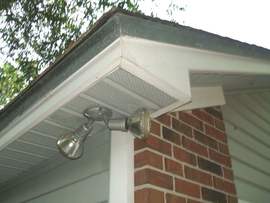 1 Roofline: Construction material, typically composed of vinyl or aluminum, used to enclose the underside of eaves and ceilings
1 Roofline: Construction material, typically composed of vinyl or aluminum, used to enclose the underside of eaves and ceilings
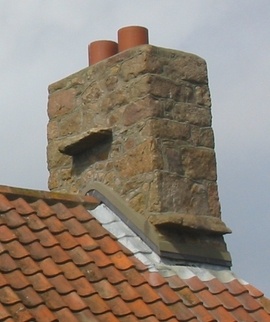 2 Flashing: Pieces of sheet metal used on roofs to cover joints, such as where the roof meets the wall, or around a chimney or skylight, to protect them and prevent water leaking through
2 Flashing: Pieces of sheet metal used on roofs to cover joints, such as where the roof meets the wall, or around a chimney or skylight, to protect them and prevent water leaking through
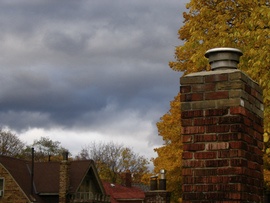 3 Flue: A duct or pipe through which exhaust gases from a fireplace, stove or boiler are released to the outdoors
3 Flue: A duct or pipe through which exhaust gases from a fireplace, stove or boiler are released to the outdoors
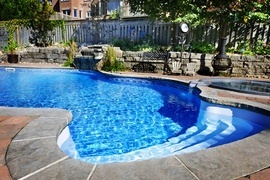 4 Liner: A covering, usually made of vinyl, for the walls and floor of a swimming pool, used to keep the water in and protect the pool's surface.
4 Liner: A covering, usually made of vinyl, for the walls and floor of a swimming pool, used to keep the water in and protect the pool's surface.
5 Firebox: The chamber in a fireplace that contains the fire. It is usually lined with firebrick so it can withstand the extreme heat that it is exposed to. Manufactured fireplaces have fireboxes made of sheet metal
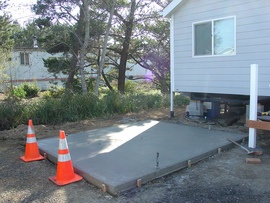 6 Concrete pad: A flat area of concrete that can be used for a variety of purposes, such as a patio or a driveway
6 Concrete pad: A flat area of concrete that can be used for a variety of purposes, such as a patio or a driveway
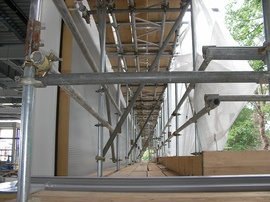 7 Scaffolding: A temporary structure used during construction/maintenance/painting projects to raise and support workers (or one worker), required materials, and equipment
7 Scaffolding: A temporary structure used during construction/maintenance/painting projects to raise and support workers (or one worker), required materials, and equipment
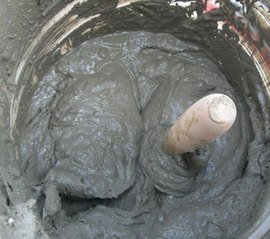 8 Mortar: A mixture of Portland cement or lime or a combination of both, sand, and water used to bind bricks, stones, and concrete masonry units together
8 Mortar: A mixture of Portland cement or lime or a combination of both, sand, and water used to bind bricks, stones, and concrete masonry units together
How Much Does It Cost To Install A Chimney
Source: https://www.fixr.com/costs/chimney-installation
Posted by: pickettfelonfuld.blogspot.com

0 Response to "How Much Does It Cost To Install A Chimney"
Post a Comment